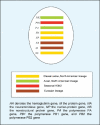The first influenza pandemic of the 21st century
- PMID: 20103951
- PMCID: PMC2850175
- DOI: 10.4103/0256-4947.59365
The first influenza pandemic of the 21st century
Abstract
The 2009 H1N1 influenza virus (formerly known as swine flu) first appeared in Mexico and the United States in March and April 2009 and has swept the globe with unprecedented speed as a result of airline travel. On June 11, 2009, the World Health Organization raised its pandemic level to the highest level, Phase 6, indicating widespread community transmission on at least two continents. The 2009 H1N1 virus contains a unique combination of gene segments from human, swine and avian influenza A viruses. Children and young adults appear to be the most affected, perhaps reflecting protection in the elderly owing to exposure to H1N1 strains before 1957. Most clinical disease is relatively mild but complications leading to hospitalization, with the need for intensive care, can occur, especially in very young children, during pregnancy, in morbid obesity, and in those with underlying medical conditions such as chronic lung and cardiac diseases, diabetes, and immunosuppression. Bacterial co-infection has played a significant role in fatal cases. The case of fatality has been estimated at around 0.4%. Mathematical modeling suggests that the effect of novel influenza virus can be reduced by immunization, but the question remains: can we produce enough H1N1 vaccine to beat the pandemic?
Figures
References
-
- Beveride WIB. The chronicle of influenza epidemics. Hist Phil Life Sci. 1991. pp. 223–235. - PubMed
-
- Johnson NP, Muller J. Updating the accounts: Global mortality of the 1918-1920 “Spanish” influenza pandemic. Bull Hist Med. 2002;76:105–15. - PubMed
-
- Monto AS. Implications of antiviral resistance of influenza viruses. Clin Infect Dis. 2009;48(4):389–96. (Comment) - PubMed
Publication types
MeSH terms
Substances
LinkOut - more resources
Full Text Sources
Miscellaneous


